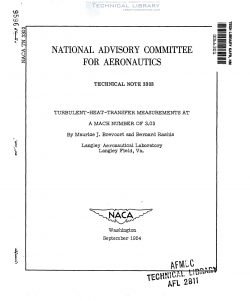naca-tn-3303
- Version
- 45 Downloads
- 550.66 KB File Size
- 1 File Count
- January 23, 2017 Create Date
- January 23, 2017 Last Updated
National Advisory Committee for Aeronautics, Technical Notes - Turbulent Heat Transfer Measurements at a Mach Number of 3.03

Turbulent-heat-transfer measurements were obtained through use of a
three—dimensional axially symmetric nozzle which consists of an inner
shaped plug and an outer cylindrical sleeve. Measurements were taken
along the outer sleeve and gave flat-plate results that are free from
wall interference and corner effects for a Mach number of 5.05 and for
a Reynolds number range of 5.6 x 106 to 6.5 x 107. The heat-transfer-
coefficient results are in good agreement with theoretical analyses and
the recovery-factor results are in good agreement with extrapolations of
lower Reynolds number data.
The design of supersonic aircraft and missiles requires engineering
information about heat-transfer coefficients and recovery factors that
extend over a wide range of Reynolds numbers. Each of the existing experi—
mental techniques for studying heat-transfer characteristics appears limited
in various ways. A test setup which utilizes a flat plate for the testing
surface is subject to corner and edge effects and also shock interference
if high Reynolds numbers are obtained by extending the plate.
One existing technique which avoids these effects is that of the
hollow cylinder mounted centrally in the test section. However, the
apparatus is subject to the tube choking at low Mach numbers and deviation
from flat—plate conditions (the boundary-layer thickness approaching a
sizable fraction of the cylinder radius) when the Reynolds numbers are
low. In addition, there are differences in the heat-transfer character—
istics for the inside and outside surfaces of the cylinders.
The purpose of this paper was to present results obtained by using
a technique that would avoid the abovefmentioned effects and permit sim—
ple and accurate measurements of local heat-transfer coefficients and
recovery factors over an extended range of both Reynolds and Mach numbers.
The development of this technique for Mach number 3.05 and the results of
preliminary heat-transfer measurements for the cooling of the surface by
the airstream are the subject of this paper.
| File | Action |
|---|---|
| naca-tn-3303 Turbulent Heat Transfer Measurements at a Mach Number of 3.03.pdf | Download |

Comment On This Post